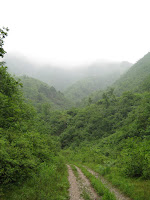Field Trip: Factory Tour
The whole BASE crew packed into two minivans this morning for a 7:15 departure. We were missing Andy, who remained asleep after two awakenings through his window, “Andy, Andy, Andy” silence, and then “Yeah?” I was wedged between a taxicab and his barred window, “Get up dude, the bus is about to leave….Are you up? Are you on your feet” I asked. He replied, “Yeah man, awhh, I’m up”, but unfortunately he never showed.

The first stop was the rock quarry. Beyond the gates were statues and sculptures lined in a row, although chaotic-looking. We walked around the main building into the yard where enormous chunks of granite and marble are stacked high. Workers were cutting, grinding, hammering, and drilling on various pieces. Matt Hope, the artist next door at BASE, showed us his latest piece, which was a huge sound resonance sculpture of granite. Multiple hunks of granite, carved to a perfect Boolean depression, formed this huge piece. There is a certain point where one can stand that makes any vocalization felt in the chest, as the sound waves form into constructive frequencies. Matt also had other pieces that were part of this project, like monolithic boulders drilled straight through, going from a very small diameter to a larger opening like a musical horn. We watched one of the workers try to drill through this thing with a hydraulic hammer dill powered by a diesel motor off to the side. I had to wear my earplugs to get close.


[Matt Hope Profile]
Matt is a tall British guy with low-sloping shoulders and a serious face. His jeans are cut-off at the calf, kind of like capris, and he wears new balance running shoes and t-shirts. Matt speaks slowly with a thick accent, swearing often as he tells stories with his head tilted downward, staring up through his deep brow. Ninety percent of what comes out his mouth makes you laugh, maybe because he uses funny British vocabulary or he is just funny as hell. He looks young, like he could be a college student, but when he smiles the crows feet next to his eyes reveal his age.

After an hour in the rock yard we climbed back into the minivans and drove down a bumpy dirt road to the actual quarry. The road was lined with car-sized hunks of marble. We pulled up to some small offices and unloaded. The sun was shinning hard, and made it almost impossible to open your eyes. It was very uncomfortable. We walked to the edge of the quarry; a huge valley cut into a solid mountain with iridescent blue and green water at the bottom. A switchback road led the trucks down to the valley. We followed it for a while and discovered an opening in the stacked hunks of marble the workers had made. It was essentially a cave that stretched back as far the eye could see, similar to a mine tunnel. The opening literally blew cold are from its depths -natural air conditioning. Inside you could even see your breath. The outside air was probably in the 90’s and the cave shaft was earth temperature, 58 degrees, which was actually too cold to endure after five minutes, especially with sweat-soaked t-shirts.

We drove into the next town over and ate lunch at a “family” restaurant, one that Jason (our Chinese translator and project coordinator at BASE) and Matt Hope really like.
The next stop was Jason’s dad’s factory, a fiberglass port-a-potty company. It wasn’t very “factory-like”. The factory was made up of a few low pole barns integrated between several courtyard homes. The fumes were almost unbearable, and the workers wore cloth masks like doctors. The highlight of this visit was the puppies that roamed around his mother’s house.

Our last destination was a steel fabrication factory where Matt Hope has some other projects in the work. This factory was a large complex with many structures. It was built in 1975 by the government and remains a state-run steel facility today. The place looks a little decrepit, but it is still functional. Machines that look like dinosaurs are dotted throughout the warehouse spaces. The buildings smell warm with a thick scent of oil and metal.






















